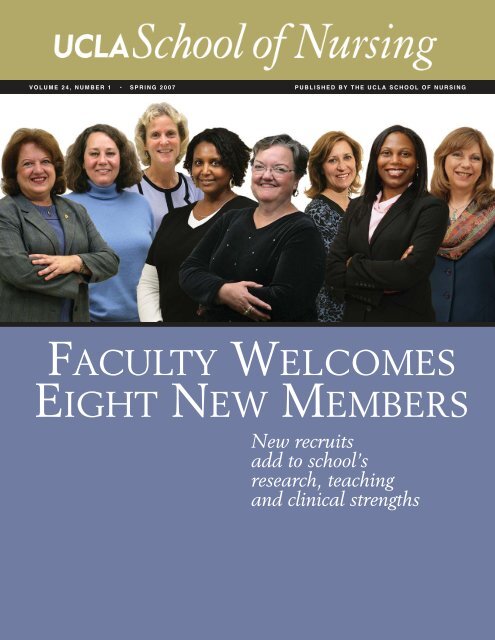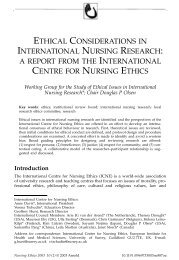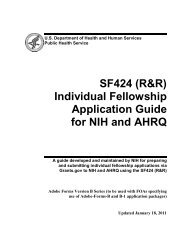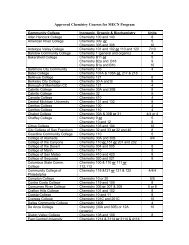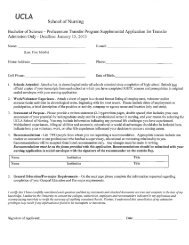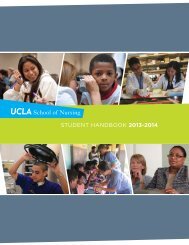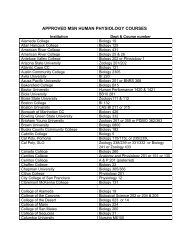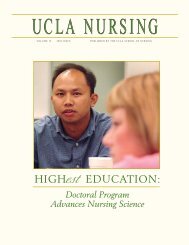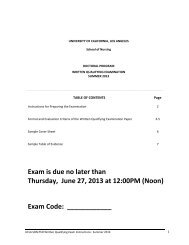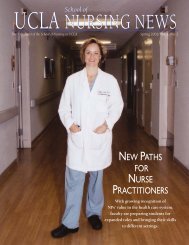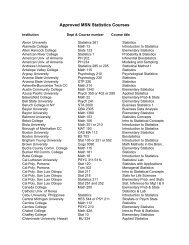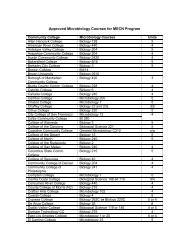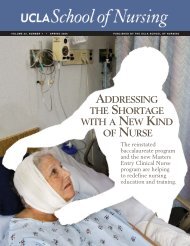You also want an ePaper? Increase the reach of your titles
YUMPU automatically turns print PDFs into web optimized ePapers that Google loves.
VOLUME 24, NUMBER 1 • SPRING <strong>2007</strong> PUBLISHED BY THE <strong>UCLA</strong> SCHOOL OF NURSING<br />
FACULTY WELCOMES<br />
EIGHT NEW MEMBERS<br />
New recruits<br />
add to school’s<br />
research, teaching<br />
and clinical strengths
MESSAGE FROM THE DEAN<br />
Last fall, the <strong>UCLA</strong> <strong>School</strong> <strong>of</strong> <strong>Nursing</strong> joyfully opened its doors to 57 new<br />
undergraduate students and to 58 students in the new Masters Entry Clinical<br />
Nurse (MECN) program, in addition to about 350 students in its existing<br />
programs. As a class, the undergraduate students are beautiful, young, energetic,<br />
creative, and smart (average GPA: 4.2; SAT: 1900). The MECN students, who<br />
already have a baccalaureate degree in another discipline, are also smart; older and<br />
wiser with fantastic life experiences; focused on nursing and “pushing the<br />
envelope.” The faculty are very impressed with the students applying to our new<br />
programs. Our goal is to provide highly educated nurses to meet the acute nursing<br />
shortage in California and nationally.<br />
The school is increasing its faculty by 22 full-time equivalent positions for<br />
the new programs. We have already hired eight tenure-track faculty this past year.<br />
Because we are a premier research school and wish to remain one, the focus <strong>of</strong> faculty recruitment has<br />
been expertise and/or potential to do research. Thus, both <strong>of</strong> our new pre-licensure programs will be<br />
taught by nurse scientists. The clinical education will be taught by practicing nurses in the hospitals<br />
(our practice partners) who have joint faculty appointments with the <strong>School</strong> <strong>of</strong> <strong>Nursing</strong>.<br />
Some <strong>of</strong> these talented faculty will be introduced to you in this issue: Barbara Bates-Jensen,<br />
Elizabeth Dixon, Jo-Ann Eastwood, Angela Hudson, Linda Searle Leach, Carol Pavlish, Linda<br />
Phillips (appointed as the Audrienne H. Moseley Endowed Chair in <strong>Nursing</strong>), and Kynna Wright.<br />
More are being recruited for the <strong>2007</strong>-08 academic year. I would like to recognize all <strong>of</strong> our existing<br />
faculty and staff in their exhausting efforts to develop the curriculum and competencies for courses for<br />
two new programs; mentor the new faculty; coordinate the clinical faculty with those teaching theory;<br />
evaluate 1,194 applications for admission to the undergraduate program for <strong>2007</strong>-08 and 300<br />
applications for admission to the MECN program for <strong>2007</strong>-08; as well as the multiple other tasks (big<br />
and small) that they have performed while continuing to teach in the existing programs, conduct their<br />
research and submit grants.<br />
Lastly, it has come to my attention that a majority <strong>of</strong> the MECN students already have<br />
educational debts <strong>of</strong> $30,000 or greater. Although scholarship funds for students have been the priority<br />
for Development for the last 10 years, we need to focus on scholarships for the MECN students<br />
immediately. Please contact Director <strong>of</strong> Development Rene Dennis for further information.<br />
Marie J. Cowan, R.N., Ph.D., F.A.A.N.
Volume 24, Number 1, <strong>Spring</strong> <strong>2007</strong><br />
SCHOOL OF NURSING<br />
ADMINISTRATION<br />
MARIE J. COWAN, R.N., Ph.D., F.A.A.N.<br />
Dean<br />
ADELINE M. NYAMATHI, R.N., Ph.D., F.A.A.N.<br />
Associate Dean, Academic Affairs<br />
SUZETTE CARDIN, R.N., D.N.Sc., F.A.A.N.<br />
Assistant Dean, Student Affairs<br />
BRYANT NG, M.B.A.<br />
Assistant Dean, Administration<br />
DEBORAH KONIAK-GRIFFIN, Ed.D., F.A.A.N.<br />
LYNN DOERING, R.N., D.N.Sc., F.A.A.N<br />
Section Chairs<br />
RENE DENNIS<br />
Director <strong>of</strong> Development<br />
PRISCILLA KEHOE, Ph.D.<br />
Director <strong>of</strong> Research<br />
JOYCE NEWMAN GIGER, Ed.D., A.P.R.N., B.C.,<br />
F.A.A.N.<br />
Faculty Chair<br />
DAN GORDON<br />
Editor and Writer<br />
MARTHA WIDMANN<br />
Art Director<br />
Photography:<br />
Reed Hutchinson (cover, p. 3, pp. 5-17, 19);<br />
Courtesy <strong>of</strong> the <strong>School</strong> <strong>of</strong> <strong>Nursing</strong> (p. 2).<br />
4<br />
NEW FACULTY<br />
& ENDOWED CHAIRS<br />
Eight Scholars Add to <strong>School</strong>’s Breadth and Depth;<br />
Two Endowed Chairs Strengthen Geriatric and Biologic Research<br />
5 Barbara Bates-Jensen<br />
6 Elizabeth Dixon<br />
7 Kynna Wright<br />
8 Carol Pavlish<br />
9 Jo-Ann Eastwood<br />
10 Linda Searle Leach<br />
11 Angela Hudson<br />
12 Endowed Chair | Linda R. Phillips<br />
14 Endowed Chair | Wendie Robbins<br />
16<br />
NEW SKILLS LAB PREPARES<br />
STUDENTS FOR PATIENT CARE<br />
State-<strong>of</strong>-the-Art Simulation Technology Allows Students<br />
to Hone Skills and Ensures Valuable Clinical Lessons<br />
18<br />
DEVELOPMENT<br />
5<br />
14<br />
16<br />
<strong>UCLA</strong> <strong>School</strong> <strong>of</strong> <strong>Nursing</strong> is published by the<br />
<strong>UCLA</strong> <strong>School</strong> <strong>of</strong> <strong>Nursing</strong> for the alumni, faculty,<br />
students, staff and friends <strong>of</strong> the school.<br />
For information about academic programs and<br />
student affairs, call (310) 825-7181, or e-mail:<br />
sonsaff@sonnet.ucla.edu<br />
Dean’s Office: (310) 825-9621<br />
Copyright <strong>2007</strong> by The Regents <strong>of</strong> the University<br />
<strong>of</strong> California. Permission to reprint any portion <strong>of</strong><br />
<strong>UCLA</strong> <strong>School</strong> <strong>of</strong> <strong>Nursing</strong> must be obtained from<br />
the editor. Contact Editor, <strong>UCLA</strong> <strong>School</strong> <strong>of</strong> <strong>Nursing</strong>,<br />
Box 951702, Los Angeles, CA 90095-1702.<br />
WWW.NURSING.<strong>UCLA</strong>.EDU<br />
19
&<br />
U C L A S C H O O L O F N U R S I N G<br />
New<br />
Faculty<br />
Endowed<br />
Chairs<br />
SCHOOL OF NURSING<br />
ENDOWED CHAIRS<br />
Dr. Deborah Koniak-Griffin<br />
Audrienne H. Moseley<br />
Endowed Chair in<br />
Women’s Health Research<br />
Dr. Joyce Newman Giger<br />
Lulu Wolf Hassenplug<br />
Endowed Chair<br />
in <strong>Nursing</strong><br />
Dr. Adey Nyamathi<br />
Audrienne H. Moseley<br />
Endowed Chair in<br />
Community Health Research<br />
Dr. Linda R. Phillips<br />
Audrienne H. Moseley<br />
Endowed Chair in <strong>Nursing</strong><br />
Dr. Wendie Robbins<br />
Audrienne H. Moseley<br />
Endowed Chair in<br />
Biological <strong>Nursing</strong> Science<br />
Eight Scholars Add to <strong>School</strong>’s Breadth<br />
and Depth; Two Endowed Chairs Strengthen<br />
Geriatric and Biologic Research<br />
THEY FOCUS ON ISSUES as wide-ranging as technology, provider-patient<br />
communications, and the impact <strong>of</strong> neighborhood conditions on health; on epidemics<br />
across the lifespan, from asthma in children to HIV and heart disease in<br />
adults, along with the special concerns <strong>of</strong> the elderly and the family members<br />
who assist them. Their research has taken them to vulnerable communities in<br />
Los Angeles and to refugee communities in Africa. They bring experience<br />
from the bedside and from the laboratory bench. Their leadership résumé includes<br />
the top position at the world’s largest specialty nursing organization.<br />
On the pages that follow, meet the eight new members <strong>of</strong> the <strong>UCLA</strong><br />
<strong>School</strong> <strong>of</strong> <strong>Nursing</strong> faculty, recruited in the last year to bolster the research,<br />
teaching and clinical strengths <strong>of</strong> a school that has expanded to include a<br />
reestablished undergraduate program and the new Masters Entry Clinical<br />
Nurse program. And meet the two endowed chairs (one <strong>of</strong> whom is among the<br />
eight new faculty members) whose funding support will help to bring renewed<br />
strength and focus to geriatric and biological nursing science at the school.<br />
4 <strong>UCLA</strong> NURSING
DR. BARBARA BATES-JENSEN<br />
Pressure ulcers, also referred to as bedsores, represent a serious quality <strong>of</strong> life problem<br />
for nursing-home residents that, in many cases, could be prevented. Clinical<br />
guidelines exist for their prevention and treatment, but are too <strong>of</strong>ten not implemented.<br />
Dr. Barbara Bates-Jensen’s work has focused on improving the quality <strong>of</strong><br />
care in nursing homes, particularly related to pressure ulcer care and skin health.<br />
Most recently, her efforts have revolved around using technology – including a<br />
Web-based s<strong>of</strong>tware system she developed – to translate research findings into<br />
everyday nursing-home practice.<br />
There are multiple explanations for why clinical practice guidelines for pressure<br />
ulcer prevention and treatment are <strong>of</strong>ten not implemented in nursing homes, Bates-<br />
Jensen says. She is addressing one that she believes to be particularly important: the<br />
insufficient use <strong>of</strong> technology. “There is no care setting that is more desperate for<br />
technology than the nursing home,” Bates-Jensen says. “All <strong>of</strong> the things we say that<br />
technology can do for nurses – give them more time at the bedside, prevent them<br />
from having to spend hours upon hours <strong>of</strong> completing paperwork – are especially<br />
needed within the nursing home setting, and yet that setting is well behind all other<br />
health care settings in terms <strong>of</strong> technology use.”<br />
Using the clinical practice guidelines for pressure ulcer prevention and assessment,<br />
Bates-Jensen has developed a Web-based quality assessment s<strong>of</strong>tware system<br />
for preventing pressure ulcers. In addition to providing a mechanism for capturing<br />
data on pressure ulcer assessments, the system includes protocols for monitoring<br />
whether or not the appropriate practices are being implemented on a routine<br />
basis. “Given that staff turnover rates are high in nursing homes, one <strong>of</strong> my<br />
goals was to develop an intervention tied to technology that could help<br />
nursing-home staff sustain changes in practice over time,” Bates-Jensen<br />
says. The s<strong>of</strong>tware she developed is designed with that in mind – a program<br />
that is simple to use and enables staff at a variety <strong>of</strong> levels to evaluate their<br />
home’s success and identify areas that need improvement. Bates-Jensen is currently<br />
evaluating the s<strong>of</strong>tware’s efficacy at a 100-bed nursing home.<br />
Her interest in using technology to assist nursing homes in sustaining<br />
changes over time has led Bates-Jensen to introduce two additional devices<br />
into the nursing-home setting. One, included with the s<strong>of</strong>tware program,<br />
is a wireless movement monitor – an object the size <strong>of</strong> a large coin that,<br />
when taped onto a nursing-home resident’s thigh, facilitates the monitoring<br />
<strong>of</strong> the individual’s horizontal and vertical movements. The device measures<br />
repositioning and activity levels. In her research, Bates-Jensen has found<br />
that turning and repositioning patients is <strong>of</strong>ten not accurately documented<br />
in the medical record; she also has found that it is not unusual for residents<br />
to go without movement for as long as six hours.<br />
A second, hand-held device measures the moisture within the epidermal<br />
tissues. There is some evidence that very early pressure-ulcer damage<br />
can be signaled by changes that take place within the tissues as an inflammatory<br />
response to cellular injury or death. In a pilot study, Bates-Jensen found<br />
that the device helped nurses predict skin damage approximately one week before<br />
it became visible. “If we can predict something before you can even see it<br />
on the skin, it increases the likelihood that we can develop interventions that<br />
would prevent the ulcer from occurring,” she says. Bates-Jensen is excited to have<br />
moved her research program to the <strong>UCLA</strong> <strong>School</strong> <strong>of</strong> <strong>Nursing</strong> and its growing cadre<br />
<strong>of</strong> faculty in geriatric nursing. “I have a great passion for this field, which has such a<br />
need for nurses at all levels,” she says. “The opportunity to share my enthusiasm<br />
with students and help to bring more young, inquisitive minds into geriatric nursing<br />
was a huge draw for me.”<br />
“The opportunity<br />
to share my enthusiasm<br />
with students and help<br />
to bring more young,<br />
inquisitive minds<br />
into geriatric nursing<br />
was a huge draw for me.”<br />
<strong>UCLA</strong> NURSING 5
DR. ELIZABETH DIXON<br />
As a public health nurse in Los Angeles County – honored as the county’s Outstanding<br />
Public Health Nurse for 1995 – Dr. Elizabeth Dixon gained an appreciation<br />
for the importance <strong>of</strong> population-focused nursing practice and the role <strong>of</strong> the<br />
social environment in influencing the health <strong>of</strong> disadvantaged groups <strong>of</strong> people.<br />
Dixon, who received her Ph.D. from the <strong>UCLA</strong> <strong>School</strong> <strong>of</strong> <strong>Nursing</strong> in 2004 and<br />
joined the faculty last year after serving as project director for the school’s Center<br />
for Vulnerable Populations Research, seeks in her studies to identify and understand<br />
the major health-promoting characteristics <strong>of</strong> social environments such as<br />
neighborhoods and workplaces – characteristics that, if manipulated, could improve<br />
the population’s health. “Changing population health behaviors through policies or<br />
other means tends to be an extremely effective strategy,” Dixon explains. For example,<br />
she notes, taxing cigarettes as a health-promotion strategy has proved effective<br />
in getting more people to stop smoking than individual education.<br />
Dixon’s previous research includes a large study <strong>of</strong> the relationships between<br />
social inequalities and health in neighborhoods. In a project that included more<br />
than 2,000 adults residing in 65 different Los Angeles County neighborhoods covering<br />
the gamut <strong>of</strong> incomes and including a wide variety <strong>of</strong> ethnic groups, she found<br />
that adult health is positively affected in neighborhoods where people have more<br />
control over their neighborhood environments and do not fear for their safety. In<br />
her research, Dixon looked at three specific neighborhood characteristics. The first,<br />
social cohesion and trust, refers to how residents get along and perceive that their<br />
neighbors are helpful. This characteristic was not found to be related to health at<br />
the neighborhood level, but the two others Dixon studied were. Informal social control<br />
is the extent to which residents perceive that other neighbors would be willing<br />
to intervene in undesirable situations for the common good <strong>of</strong> the group. For example,<br />
people in a neighborhood with informal social control would be more likely to<br />
join forces to block a liquor store from being opened if the business was deemed to<br />
have the potential to attract unsavory elements into the area. This characteristic,<br />
along with a third – perceptions <strong>of</strong> safety – were found by Dixon to be influential<br />
in determining the health <strong>of</strong> people in neighborhoods.<br />
“Nurses can harness the power <strong>of</strong> these types <strong>of</strong> characteristics by helping people<br />
feel a sense <strong>of</strong> control over their neighborhoods and helping them to realize<br />
that they can make a difference, to a certain extent, in controlling their environments,”<br />
Dixon says, pointing to participation in Neighborhood Watch programs and<br />
Los Angeles’ Neighborhood Councils as examples. Nurses can also work with community-based<br />
organizations to enhance these characteristics through community<br />
capacity-building, she notes.<br />
Dixon is now examining how worksite policies influence the health <strong>of</strong><br />
employees. Policies ranging from the types <strong>of</strong> foods available in lunch rooms<br />
and cafeterias to whether there are opportunities and/or incentives for<br />
workers to engage in physical activity during work hours may have an important<br />
impact on worker health, she says.<br />
“I’m primarily interested in investigating and working with healthpromotion<br />
activities directed toward groups and populations, because<br />
changes at this level can have a greater impact,” Dixon says. “Individual-level<br />
interventions and health education are very important, but<br />
they have to be complemented by larger structural changes and<br />
health-promoting activities.”<br />
“I’m interested in<br />
investigating and working<br />
with health-promotion<br />
activities directed toward<br />
groups and populations,<br />
because changes<br />
at this level can have<br />
a greater impact.”<br />
6 <strong>UCLA</strong> NURSING
“Despite the fact<br />
that we were following<br />
the national guidelines<br />
on how to treat asthma,<br />
we were still seeing<br />
exacerbations.<br />
I knew, as a result,<br />
that we needed<br />
to begin thinking<br />
‘out <strong>of</strong> the box.’ ”<br />
DR. KYNNA WRIGHT<br />
Asthma and obesity are chronic health conditions with two key characteristics in<br />
common: Both are increasing at alarming levels among school-age children, and<br />
both disproportionately affect poor and underserved populations, particularly in<br />
Latino and African American communities. Dr. Kynna Wright’s research is exploring<br />
the factors driving the increase in childhood asthma, particularly as it relates to<br />
access to and utilization <strong>of</strong> health care services among underserved populations; and<br />
the links between asthma and obesity among Latino and African American children.<br />
“I am interested in learning why we still have these high rates <strong>of</strong> asthma among<br />
vulnerable populations despite the fact that access to health care has increased –<br />
most <strong>of</strong> the state’s children are now insured – and we now have state-<strong>of</strong>-the-art<br />
medications to treat and/or prevent asthma,” Wright says. “At the same time, obesity<br />
is at epidemic levels among school-age kids, and, like asthma, is hitting the underserved<br />
hard. The literature suggests that there are some links between asthma<br />
and obesity, but this needs to be studied more.”<br />
Wright, who joined the <strong>UCLA</strong> <strong>School</strong> <strong>of</strong> <strong>Nursing</strong> faculty last year and is a<br />
member <strong>of</strong> the school’s Center for Vulnerable Populations Research, intends to examine<br />
these issues and, based on her findings, develop interventions to help prevent<br />
obesity and asthma exacerbations. To do so, she is engaging in communitybased<br />
participatory research, an approach, championed by the center, in which the<br />
community stakeholders are equal partners in the project. Wright has been working<br />
with one community-based organization on an intervention that would involve parents<br />
as well as their children. “Because parents are very involved in their children’s<br />
health, it’s important to find an intervention that they support and that involves<br />
them as well as their kids,” she explains.<br />
Wright’s doctoral dissertation at the <strong>UCLA</strong> <strong>School</strong> <strong>of</strong> Public Health examined<br />
racial/ethnic disparities in health care access and utilization among children with<br />
asthma, using data from the 2001 California Health Interview Survey. Her findings<br />
on the magnitude <strong>of</strong> the problem confirmed what she had seen anecdotally as<br />
a ped-iatric nurse practitioner working in underserved communities. “More than<br />
half <strong>of</strong> my clients were asthmatic,” Wright says, “and despite the fact that we<br />
were following the national guidelines on how to treat asthma, we were still seeing<br />
exacerbations and kids missing a lot <strong>of</strong> school because <strong>of</strong> their condition. I<br />
knew, as a result, that we needed to begin thinking ‘out <strong>of</strong> the box’ to find ways<br />
to intervene.”<br />
At the same time, she was deeply influenced by Dr. Francine Kaufman,<br />
author <strong>of</strong> the 2005 book Diabesity on the rise <strong>of</strong> obesity-related diabetes<br />
in children. “Dr. Kaufman’s book illustrated several ways that<br />
the community could be involved in helping to overcome this obesity<br />
epidemic,” Wright says. Wright continues to see underserved patients<br />
at the Westside Family Health Clinic. “I learn a lot from my patients –<br />
they keep me humble,” she says. “There is a huge need for safety-net<br />
providers, and I am hoping that some <strong>of</strong> the nurse practitioners I train<br />
will consider that route.”<br />
Wright is herself a graduate <strong>of</strong> the <strong>UCLA</strong> <strong>School</strong> <strong>of</strong> <strong>Nursing</strong>, having<br />
completed the school’s Pediatric Nurse Practitioner program in 1997. She<br />
maintained ties with the school, co-teaching a physical assessment course<br />
for several years. “I’m very interested in helping to promote excellence in<br />
the field <strong>of</strong> nursing,” she says, “and with the new programs that have recently<br />
opened at the school, this is an exciting time to join the faculty.”<br />
<strong>UCLA</strong> NURSING 7
“We can and should<br />
play an important role<br />
as advocates<br />
on social, economic,<br />
and political issues<br />
such as those that<br />
have been identified<br />
by these<br />
refugee communities.”<br />
DR. CAROL PAVLISH<br />
Dr. Carol Pavlish conducts research in the refugee camps <strong>of</strong> war-ravaged nations<br />
such as Rwanda and Sudan, and in health care settings in the United States where<br />
palliative care is provided to terminally ill patients. Although these two interests<br />
may seem worlds apart, Pavlish sees a connection. “In both cases I’m listening to<br />
marginalized voices,” she explains.<br />
At home – which from 1978-2006 was College <strong>of</strong> St. Catherine in St. Paul,<br />
Minn., and is now the <strong>UCLA</strong> <strong>School</strong> <strong>of</strong> <strong>Nursing</strong> – Pavlish has sought to give voice to<br />
the needs <strong>of</strong> dying patients and their families. As a certified oncology nurse, she is<br />
particularly interested in helping to implement the emerging view <strong>of</strong> palliative care<br />
as a partnership between palliative care specialists and other health pr<strong>of</strong>essionals.<br />
“It used to be that palliative care was considered comfort care when no other<br />
treatment was available,” Pavlish says. “Now, a lot <strong>of</strong> organizations have shifted to a<br />
view in which palliative-care specialty teams become partners with the actively<br />
treating teams much earlier in the course <strong>of</strong> a patient’s life-threatening disease. So<br />
many treatments create a lot <strong>of</strong> discomfort and diminish quality <strong>of</strong> life, and palliative-care<br />
specialty teams can help manage those aspects <strong>of</strong> living with the disease.”<br />
Pavlish has sought to improve the plight <strong>of</strong> marginalized populations on the<br />
other side <strong>of</strong> the world through her work for the last several years with the American<br />
Refugee Committee (ARC), an international non-governmental organization<br />
that administers health care services for refugee camps in 10 countries. In conjunction<br />
with the ARC, Pavlish went to Rwanda to learn more about the health needs <strong>of</strong><br />
refugee women from the Democratic Republic <strong>of</strong> Congo who have been living in<br />
Rwandan border camps since the 1994 genocide in Rwanda. At the behest <strong>of</strong> the<br />
community <strong>of</strong> refugee women, Pavlish helped to implement a collaborative, capacity-building<br />
program by teaching 13 refugee women how to plan and facilitate<br />
focus-group sessions with the larger community <strong>of</strong> refugee women.<br />
Among other things, focus groups revealed concerns about the health implications<br />
<strong>of</strong> poverty, the struggle for survival, the overburden <strong>of</strong> daily work for<br />
women, ambivalence about family planning, and the lack <strong>of</strong> freedom in selfexpression.<br />
ARC used the data to restructure some <strong>of</strong> its health care delivery,<br />
expand the capacity <strong>of</strong> community health workers to address women’s health<br />
concerns, and initiate plans for income-generation projects.<br />
Pavlish has returned to the area several times, working with the refugee<br />
community to explore the topic <strong>of</strong> gender-based violence and analyze community<br />
readiness for a legal aid clinic. Most recently, she went to south Sudan and northern<br />
Uganda last September to learn more about the issue <strong>of</strong> gender-based<br />
violence by working with the women and girls, in conjunction with a<br />
consortium <strong>of</strong> agencies that included ARC, UNICEF, and faith-based<br />
organizations in the area. Based on those findings, Pavlish and colleagues<br />
have established a four-phase research project that will seek<br />
to document how the issue is perceived by the population in the<br />
context <strong>of</strong> their understanding <strong>of</strong> a human rights, justice framework<br />
and gender relations and then develop and implement interventions<br />
that are community-based, respectful <strong>of</strong> local realities, and<br />
observant <strong>of</strong> universal norms on human and people’s rights as advanced<br />
by the African Union.<br />
“Nurses have always understood that health has to do with much<br />
more than physical ailments; it is determined by the context in which<br />
people live,” says Pavlish. “We can and should play an important role<br />
as advocates on social, economic, and political issues such as those<br />
that have been identified by these refugee communities.”<br />
8 <strong>UCLA</strong> NURSING
DR. JO-ANN EASTWOOD<br />
During her 25 years in critical care nursing, Dr. Jo-Ann Eastwood recognized a serious<br />
deficiency in the treatment <strong>of</strong> women with heart disease, so Eastwood decided<br />
to pursue her part and address the shortage <strong>of</strong> data on how cardiovascular disease<br />
affects women. Until the early 1990s, women were typically excluded from clinical<br />
studies on heart disease, with results from studies <strong>of</strong> males simply applied to<br />
females for the purposes <strong>of</strong> diagnosis and treatment. “We now know that cardiovascular<br />
disease runs a very different course for women,” says Eastwood, who joined<br />
the faculty after completing her Ph.D. at the school.<br />
As a doctoral student, Eastwood studied patients undergoing an initial angiogram<br />
for the diagnosis <strong>of</strong> coronary heart disease and the impact <strong>of</strong> uncertainty<br />
and psychosocial variables on the patient’s health-related quality <strong>of</strong> life. Upon completing<br />
her Ph.D., Eastwood continued the study <strong>of</strong> 48 men and 52 women, in an<br />
effort to compare the psychosocial, physical, and quality <strong>of</strong> life outcomes. “Intuitively<br />
we would think that patients who had been told that the angiogram was negative<br />
would have little or no untoward psychological effects from the experience,”<br />
Eastwood says. “However, even after one year the group without heart disease had<br />
lower quality <strong>of</strong> life scores than the patients with heart disease. This identifies a<br />
new population for nursing to design educational and supportive interventions.”<br />
Women get cardiovascular disease approximately 10 years later than men because<br />
they are mostly protected by their estrogen levels prior to menopause. “Since<br />
female heart disease patients tend to be older, they have more accompanying physical<br />
conditions and higher rates <strong>of</strong> depression, which is highly correlated with heart<br />
disease,” Eastwood explains.<br />
Eastwood’s early career included positions as a critical care staff nurse for neurosurgical,<br />
neurological and trauma patients; as the research nurse responsible for running<br />
a hyperbaric chamber; and as a critical care nurse in the first fully funded heart<br />
transplant center, at Stanford University. At Little Company <strong>of</strong> Mary Hospital in<br />
Torrance, Calif., she became a critical care instructor and ultimately served as supervisor<br />
<strong>of</strong> nursing patient education. In 1995, she began working as a certification<br />
specialist for the American Association <strong>of</strong> Critical-Care Nurses; while there, she<br />
conceived and implemented a national certification examination for clinical nurse<br />
specialists in adult, pediatric, and neonatal critical care. Eastwood’s research credentials<br />
were bolstered by her associations as a doctoral student with her faculty<br />
mentor, Dr. Lynn Doering, who is renowned for her research in depression and immune<br />
dysfunction after coronary artery bypass surgery; and with Dean Marie<br />
Cowan, who hired Eastwood as project director for a four-year study Cowan headed<br />
comparing care management by an acute care nurse practitioner and hospitalist<br />
multidisciplinary team with care management by a standard team <strong>of</strong> doctors<br />
and nurses.<br />
For her own research program, Eastwood’s goal is to find ways to identify<br />
more women who show no clinical signs <strong>of</strong> heart disease but are experiencing<br />
sub-clinical changes that could be reversed with early treatment.<br />
She is currently looking into the possibility that a simple ultrasound<br />
could detect the thickening <strong>of</strong> the carotid arteries – an early warning<br />
sign for heart disease.<br />
“The treatments are out there – statins, the correct diet and<br />
antioxidants can actually make the plaque in the arteries regress,”<br />
Eastwood says. “We need to find women who have early signs<br />
and treat them before they experience a coronary event that<br />
would be detrimental to the quality <strong>of</strong> their remaining years. If<br />
we found an economic way to screen the most at-risk populations,<br />
we could decrease the incidence <strong>of</strong> heart disease and improve lives.”<br />
“We need to find<br />
women who have<br />
early signs and treat them<br />
before they experience<br />
a coronary event<br />
that would be detrimental<br />
to the quality <strong>of</strong><br />
their remaining years.”<br />
<strong>UCLA</strong> NURSING 9
DR. LINDA SEARLE LEACH<br />
As president <strong>of</strong> the American Association <strong>of</strong> Critical-Care Nurses (AACN) nearly<br />
two decades ago, Dr. Linda Searle Leach gained a unique perspective on the importance<br />
<strong>of</strong> effective nursing leadership. In the years since she headed the world’s<br />
largest specialty nursing organization, Leach has taught and pursued research toward<br />
the goal <strong>of</strong> identifying factors in the health care practice environment that contribute<br />
to optimal delivery <strong>of</strong> care by nurses and other health pr<strong>of</strong>essionals.<br />
Leach had a rich career prior to entering academia, working first as a critical<br />
care nurse and then as a nurse administrator. She was a clinical nurse specialist and<br />
director <strong>of</strong> critical care at Santa Monica Hospital Medical Center, and surgical nursing<br />
director at Cedars-Sinai Medical Center. In her role as president <strong>of</strong> the AACN<br />
in 1988-89, she traveled the country and served as a media spokesperson on the<br />
nursing-shortage crisis, among other issues. “Being in that national leadership position<br />
was a transforming opportunity that influenced some <strong>of</strong> the choices I ultimately<br />
made after that,” Leach says.<br />
Her theme in her communications as president was the difference that nurses<br />
make in the lives <strong>of</strong> patients and their families, and once Leach’s AACN leadership<br />
service was complete, she decided to enter academia to teach and pursue research<br />
in that area. From 1992-2001 she served as an assistant clinical pr<strong>of</strong>essor at USC<br />
while also working toward her doctorate. Her research confirmed the importance <strong>of</strong><br />
the nurse executive role and documented the relationship between positive nurseexecutive<br />
leadership and organizational commitment among nurses. As an assistant<br />
pr<strong>of</strong>essor <strong>of</strong> nursing at California State University, Fullerton, from 2001-2004,<br />
Leach taught nursing research and pr<strong>of</strong>essional issues and conducted research on<br />
the practice environment <strong>of</strong> nurses.<br />
Not long before she joined the <strong>UCLA</strong> <strong>School</strong> <strong>of</strong> <strong>Nursing</strong> faculty, Leach coauthored<br />
a major policy report, California’s <strong>Nursing</strong> Workforce: Increasing Capacity in<br />
<strong>School</strong>s <strong>of</strong> <strong>Nursing</strong> for the California Institute for <strong>Nursing</strong> and Health Care. The report,<br />
which was requested by the governor, outlined recommendations to address nursing<br />
educational capacity issues for the state <strong>of</strong> California. It was instrumental in the decision<br />
that led to reinstatement <strong>of</strong> the school’s undergraduate nursing program and<br />
the establishment <strong>of</strong> the new Masters Entry Clinical Nurse (MECN) program.<br />
At <strong>UCLA</strong>, Leach, who is teaching a health care policy course to MECN students,<br />
continues to delve into the impact <strong>of</strong> the practice environment on nursing<br />
while also exploring the pr<strong>of</strong>essional role <strong>of</strong> the nurse in teams. She is currently<br />
analyzing data from a study <strong>of</strong> rapid response teams – hospital teams, typically<br />
headed by a critical care nurse, that are designed to intervene at the earliest<br />
signs <strong>of</strong> a patient’s decline. “These teams bring in the right resources at the<br />
right time – nurses initiate a call to the team to help intervene when a patient<br />
is becoming unstable,” Leach explains. Her study, which interviewed nurses<br />
who have called for a rapid response team as well as those who have served<br />
on such teams, will describe the contribution these nurse-led teams are<br />
making in saving lives.<br />
“Patients in the hospital setting are much more complex and vulnerable<br />
than they were in the past,” Leach says. “Because <strong>of</strong> that, it’s more important<br />
than ever to understand the factors that assist nurses in making<br />
their optimal contribution to patient care.”<br />
“Patients in the hospital<br />
setting are much<br />
more complex and vulnerable<br />
than they were in the past.<br />
Because <strong>of</strong> that, it’s more<br />
important than ever<br />
to understand the factors<br />
that assist nurses<br />
in making their optimal<br />
contribution to patient care.”<br />
10 <strong>UCLA</strong> NURSING
“Patients need to feel<br />
empowered to take the<br />
initiative and ask<br />
questions, and providers<br />
need to make sure<br />
their patients can<br />
decipher the information<br />
being conveyed.”<br />
DR. ANGELA HUDSON<br />
Health literacy – the ability <strong>of</strong> patients to access and understand knowledge they<br />
can use for self-care and health promotion – has gained national attention as an<br />
issue that must be better addressed. “The patient-provider relationship is very powerful,<br />
so the information patients get from their provider is extremely important, but<br />
too many patients don’t understand what they’re told,” says Dr. Angela Hudson,<br />
who joined the <strong>UCLA</strong> <strong>School</strong> <strong>of</strong> <strong>Nursing</strong> faculty last July after five years on the faculty<br />
at California State University, Fresno, where she taught maternity and newborn<br />
nursing to nurse practitioner students and a research course for undergraduates.<br />
“Patients need to feel empowered to take the initiative and ask questions, and<br />
providers need to make sure their patients can decipher the information being<br />
conveyed.”<br />
It came as no surprise when Hudson found herself drawn to the problem. “I<br />
come from a family <strong>of</strong> teachers, and I was looked at as the oddball in that I went<br />
into a different kind <strong>of</strong> service,” she says, smiling. “But in nursing we also do a lot<br />
<strong>of</strong> teaching.” As a nurse practitioner, Hudson became particularly interested in<br />
teaching HIV patients. In addition to providing ambulatory care to HIV-positive patients,<br />
she served as a nursing coordinator at an AIDS clinic and later as a case manager<br />
in a hospital HIV unit.<br />
Her research initially focused on symptom management for patients with<br />
chronic illnesses. “For chronic conditions such as HIV, diabetes, or even<br />
menopausal symptoms, most <strong>of</strong> the onus <strong>of</strong> health care maintenance is on what patients<br />
do at home,” she explains, “so we need to know what information these patients<br />
get from their providers, how much they understand, and how they translate<br />
that information into self-care.”<br />
Hudson is currently examining pregnant and postpartum women’s attitudes<br />
about prenatal HIV testing. One-fourth <strong>of</strong> the approximately 1 million U.S. residents<br />
living with HIV are unaware that they are infected. This prevents these 250,000 individuals<br />
from receiving treatment that could improve their health and extend their<br />
lives – treatment that is more effective when begun earlier in the course <strong>of</strong> the disease.<br />
Last September, the federal Centers for Disease Control and Prevention<br />
(CDC) issued new guidelines calling for voluntary universal HIV testing. The new<br />
guidelines aim to remove barriers to HIV screening that have been found to get in<br />
the way <strong>of</strong> both patients and their health care providers seeking tests.<br />
Many women decline to be tested for HIV because <strong>of</strong> fear and the stigma that<br />
has been attached to taking the test, Hudson notes. In particular, she hopes to<br />
identify ways to increase voluntary testing among African American and Hispanic<br />
women, who comprise the majority <strong>of</strong> women infected with HIV.<br />
Hudson continues to volunteer as a nurse practitioner for a Planned Parenthood<br />
clinic, where she provides prenatal care. “For several years, the standard<br />
has been to <strong>of</strong>fer an HIV test to all pregnant women to decrease the risk <strong>of</strong> vertical<br />
transmission from mother to child,” she says. Hudson notes that many<br />
women, when <strong>of</strong>fered the test by a receptionist or medical assistant, will decline.<br />
Often, when she provides more information on the benefits <strong>of</strong> knowing<br />
their HIV status, these same patients change their mind and consent to the<br />
test.<br />
“It goes back to the power <strong>of</strong> the provider-patient relationship,” Hudson<br />
says. “If the health provider successfully communicates the right information<br />
to patients and removes the stigma around HIV testing, I believe it can make a<br />
huge difference.”<br />
<strong>UCLA</strong> NURSING 11
ENDOWED CHAIR<br />
DR. LINDA R. PHILLIPS<br />
Early in her career, as a public health nurse visiting homes where frail elderly individuals<br />
were being tended to by family members, Dr. Linda R. Phillips was struck<br />
by the discrepancy between the successful caregivers and the not-so-successful ones.<br />
“It might sound obvious, but it is generally not acknowledged that some families<br />
do better at providing care than others,” says Phillips, who joined the <strong>UCLA</strong><br />
<strong>School</strong> <strong>of</strong> <strong>Nursing</strong> faculty in the fall as the Audrienne H. Moseley Endowed Chair<br />
in <strong>Nursing</strong>. “We mistakenly assume that if the family is providing the care, it is the<br />
right and best thing for the elderly family member.”<br />
Phillips saw firsthand that this was not the case. She found instances <strong>of</strong> abuse,<br />
but also situations in which family caregivers, while not willfully abusive, were either<br />
neglectful or incompetent for the role. Phillips recalls going to the home <strong>of</strong> one<br />
debilitated elderly patient who had bruises on both sides <strong>of</strong> her face in the shape <strong>of</strong><br />
finger marks. When Phillips spoke with the daughter who was providing the care,<br />
she learned that the patient had not been eating and the daughter had been holding<br />
her face and force-feeding her. “This woman had the best <strong>of</strong> intentions, but she<br />
was obviously not handling the situation well,” Phillips says. “It was very difficult<br />
to know what nurses should do in situations like that.”<br />
Her interest piqued, Phillips decided to return to school for her Ph.D. Ever<br />
since, her career has been devoted to teaching, studying, and finding solutions to<br />
the problems <strong>of</strong> elder abuse, family caregiving and nursing interventions for frail elders.<br />
After more than two decades on the faculty at the University <strong>of</strong> Arizona College<br />
<strong>of</strong> <strong>Nursing</strong>, she was recruited to the endowed chair at the <strong>UCLA</strong> <strong>School</strong> <strong>of</strong><br />
<strong>Nursing</strong> last year.<br />
While elder abuse is part <strong>of</strong> the issue, a more general concern for nurses is the<br />
overall quality <strong>of</strong> family care for frail elders whether it’s abusive or not, explains<br />
12 <strong>UCLA</strong> NURSING
Phillips, who has studied all types <strong>of</strong> families and<br />
elder populations, including those with dementia,<br />
chronic heart failure, cancer, stroke, and<br />
other conditions.<br />
There have been many studies on family<br />
caregivers, but little research specifically focusing<br />
on the quality <strong>of</strong> the care they give, Phillips notes.<br />
At the outset <strong>of</strong> her investigative program, she believed<br />
that education was the answer to the problem.<br />
“I thought that if we simply gave people<br />
enough factual information, they would do the<br />
right thing,” Phillips recalls, “and what I learned<br />
is that it’s much more complicated than that.”<br />
The caregiver experience is extremely complex,<br />
she says. Because nurses and other health<br />
pr<strong>of</strong>essionals have little time to spend with each<br />
family, they don’t get to know them well and,<br />
therefore, are likely to presume that with the<br />
right information, the family members will provide<br />
quality care. But research has shown that<br />
the education family caregivers receive tends to<br />
be inadequate.<br />
issue.” Family caregivers need long-term, intensive<br />
relationships with people who will support<br />
them, Phillips contends. That can be in the form<br />
<strong>of</strong> lay interventions such as support groups;<br />
<strong>of</strong>ten, though, caregivers are unable to get to the<br />
groups, or their situation is too complex to be alleviated<br />
in the group setting. In such cases, a<br />
supportive, informed listener can be the most<br />
helpful, and <strong>of</strong>ten it is nurses who fulfill that<br />
role, Phillips says.<br />
Although her research has <strong>of</strong>ten focused on<br />
the negative sides <strong>of</strong> caregiving, Phillips recently<br />
completed a study that highlighted the moving<br />
stories <strong>of</strong> family members providing care for a<br />
dying relative. “It was heart-wrenching to hear<br />
these wonderful stories about what it means to<br />
provide care to a loved one who is dying,” she<br />
says. As a follow-up, Phillips is now collaborating<br />
with her <strong>UCLA</strong> <strong>School</strong> <strong>of</strong> <strong>Nursing</strong> colleague, Dr.<br />
Joyce Giger, to replicate this study using a crosscultural<br />
perspective. At the same time, Phillips<br />
“There are so many unanswered questions, as well as things we know a lot about that are not being<br />
transferred into the clinical arena. By combining the different skills and expertise <strong>of</strong> our gerontological<br />
nursing faculty through collaborations, we can do a better job <strong>of</strong> making a difference in practice.”<br />
Thus, Phillips began to focus on understanding<br />
the nature <strong>of</strong> the life-long relationships between<br />
frail elders and their family caregivers in<br />
the context <strong>of</strong> the caregiving role. “I have tried to<br />
learn what we need to do to help caregivers deal<br />
with a lot <strong>of</strong> the baggage they bring with them to<br />
caregiving,” Phillips explains. Sometimes,<br />
Phillips has learned, the content <strong>of</strong> the information<br />
itself needs to go beyond the mechanics <strong>of</strong><br />
the care being provided. In one <strong>of</strong> her recent<br />
studies, an intervention that gave caregivers factual<br />
information designed to assist them in being<br />
non-confrontational made a significant impact.<br />
“Most interventions in caregiving research<br />
have focused on reducing the caregiving burden,”<br />
Phillips says. “I have concluded from my<br />
research that this burden is exacerbated by relationship<br />
issues. It’s not just about how hard it is<br />
to be a caregiver; it’s how hard it is to be a wife<br />
or daughter who also happens to be a caregiver<br />
for that spouse or parent. Services such as respite<br />
are helpful, but that’s not always the crux <strong>of</strong> the<br />
continues to have an interest in elder abuse, neglect<br />
and mistreatment in all settings. She recently<br />
submitted a proposal to study abuse in<br />
residential care facilities.<br />
Phillips says she was drawn to <strong>UCLA</strong> by the<br />
reputation <strong>of</strong> <strong>School</strong> <strong>of</strong> <strong>Nursing</strong> faculty as well as<br />
<strong>UCLA</strong>’s overall excellence in geriatrics. She<br />
joins a growing group <strong>of</strong> faculty at the school<br />
who are interested in various aspects <strong>of</strong> gerontology.<br />
With the resources made available through<br />
the endowed chair, Phillips has begun to bring<br />
these faculty together in pursuit <strong>of</strong> a unified<br />
focus and strategy for developing knowledge in<br />
geriatric nursing.<br />
“There are so many unanswered questions,<br />
as well as things we know a lot about that are not<br />
being transferred into the clinical arena,” she<br />
says. “By combining the different skills and expertise<br />
<strong>of</strong> our gerontological nursing faculty<br />
through collaborations, we can do a better job <strong>of</strong><br />
making a difference in practice.”<br />
<strong>UCLA</strong> NURSING 13
ENDOWED CHAIR<br />
DR. WENDIE ROBBINS<br />
“Bench to bedside” is a phrase commonly used in biomedical science to describe<br />
the translation <strong>of</strong> laboratory findings into clinically useful strategies. Dr. Wendie<br />
Robbins began her career “at the bedside” as an obstetrical-gynecological nurse,<br />
but became disturbed by what she suspected were preventable reproductive problems<br />
affecting certain patient populations more than others. So Robbins went back<br />
to school for her Ph.D., shifting her focus from the bedside to the bench in an effort<br />
to do something about the problems she had seen.<br />
Today, as a biologic nurse scientist at the <strong>UCLA</strong> <strong>School</strong> <strong>of</strong> <strong>Nursing</strong>, she brings<br />
her unique perspective to reproductive toxicology studies and works with epidemiologists,<br />
environmental scientists, nurses and other clinical experts to translate the<br />
findings into better health outcomes for parents and children. And as the newly appointed<br />
Audrienne H. Moseley Endowed Chair in Biological <strong>Nursing</strong> Science, Robbins<br />
heads a growing cadre <strong>of</strong> biological nurse scientists at the school who are conducting<br />
basic research to address important questions <strong>of</strong> their own.<br />
While working as a nurse practitioner in rural public health clinics in the 1980s,<br />
Robbins saw patterns in families experiencing poor reproductive outcomes that led<br />
her to suspect links to environmental or occupational exposures. “I began to think<br />
about the potential influence <strong>of</strong> the environment on reproductive health,” she says.<br />
“We would travel long distances through flat desert to get to one particular clinic,<br />
and as we approached you would see a plume <strong>of</strong> dense smoke coming from the<br />
main industry in town, a copper smelter. You couldn’t help but wonder whether<br />
some <strong>of</strong> the clinical outcomes you were encountering were related to that plume<br />
drifting over the homes in the community surrounding the plant.”<br />
Deciding that pursuing a career as a nurse scientist would enable her to make<br />
contributions that might prevent many tragic reproductive outcomes from occurring<br />
and promote health for parents and children, Robbins began doctoral studies at UC<br />
Berkeley. She did her dissertation with the Biomedical Research Group at Lawrence<br />
Livermore Laboratory. After earning her Ph.D., Robbins spent three years as a<br />
14 <strong>UCLA</strong> NURSING
member <strong>of</strong> the clinical research faculty at the<br />
University <strong>of</strong> North Carolina at Chapel Hill,<br />
<strong>School</strong> <strong>of</strong> Public Health. In 1997, she was recruited<br />
to the <strong>UCLA</strong> <strong>School</strong> <strong>of</strong> <strong>Nursing</strong> to serve on<br />
the faculty and direct the school’s Occupational<br />
and Environmental Health <strong>Nursing</strong> Program.<br />
better comprehending people’s reproductive<br />
risks from various exposures, we can take measures<br />
to reduce those risks and promote healthy<br />
outcomes for parents and children.”<br />
The research tools Robbins can now draw on<br />
to answer questions such as these have become<br />
far more powerful since her bench career began.<br />
But Robbins points to another change as being<br />
equally significant in advancing her efforts. “Scientific<br />
inquiry is increasingly collaborative,” she<br />
says. “The goal is to learn things from bench research<br />
that can be implemented in patient care<br />
and health, and to do that you need to work in<br />
multidisciplinary teams. Nurses have a distinct<br />
role in this effort, and that’s why this biological<br />
endowed chair is such a great opportunity.”<br />
These are challenging but exciting times for<br />
basic-science nurse researchers, Robbins says.<br />
“Current numbers <strong>of</strong> biologic, bench nurse scientists<br />
are small and because <strong>of</strong> this, their capability<br />
is <strong>of</strong>ten overlooked or under-funded. On<br />
“This endowed chair is a great opportunity to build on our strong cadre <strong>of</strong> bench researchers who<br />
are addressing different biological issues through their unique nursing perspective.”<br />
In the last decade, her lab has evaluated<br />
human sperm cells for chromosomal abnormalities<br />
resulting from environmental, occupational<br />
or lifestyle exposures. Robbins’ group has published<br />
studies on the effects on sperm DNA<br />
from smoking, alcohol and caffeine; from<br />
chemotherapy; from the antiretroviral agents<br />
used to treat HIV infection; from organophosphate<br />
pesticides; and from air pollution. She also<br />
went to China for a study <strong>of</strong> male reproductive<br />
effects from occupational exposure to boron.<br />
Her group has found that certain chemotherapy<br />
drugs increase aneuploidy – a condition<br />
characterized by an abnormal increase in chromosomes<br />
– in sperm cells during and immediately<br />
after treatment, with the sperm returning to<br />
pre-treatment chromosome numbers by six<br />
months after conclusion <strong>of</strong> the therapy. Conceptions<br />
taking place during this period <strong>of</strong> increased<br />
sperm disomy are at risk for adverse health outcomes<br />
such as Klinefelter’s syndrome, Down<br />
syndrome, mental retardation and other developmental<br />
disabilities.<br />
Robbins further found that aneuploidy can<br />
result from high levels <strong>of</strong> exposure to air pollution<br />
and smoking. Her pesticide studies found<br />
an increase in nullisomy – a missing sex chromosome<br />
– in sperm cells. In her research on the reproductive<br />
effects <strong>of</strong> occupational exposure to<br />
boron among male workers who mine the element<br />
in Liaoning Province, China, Robbins<br />
found that high exposure levels changed the<br />
ratio <strong>of</strong> Y- to X-bearing sperm, potentially influencing<br />
the gender <strong>of</strong> their <strong>of</strong>fspring.<br />
“In almost any health outcome, environment<br />
and underlying genetics both play a role, and if<br />
we want to understand these outcomes, we need<br />
to try to decipher what is genetic, what is environment,<br />
and how we might promote health<br />
through that understanding,” Robbins says. “By<br />
the other hand, this is an excellent time at<br />
<strong>UCLA</strong> to build a reputation for nurses as biologic<br />
scientists because units across campus are embracing<br />
interdisciplinary collaborations.” Opportunities<br />
for basic biological nurse researchers are<br />
presenting themselves in the disciplines <strong>of</strong> genetics,<br />
stem cells, nano-science, immunology,<br />
imaging, neurobiology, molecular biology and<br />
molecular toxicology, Robbins says. Moreover,<br />
as the <strong>School</strong> <strong>of</strong> <strong>Nursing</strong> expands programs to<br />
include new graduate and undergraduate student<br />
streams, early mentoring in basic laboratory<br />
research can build a rich pool <strong>of</strong> doctoral candidates<br />
for the biological nurse scientist role.<br />
“Nurses play a critical role as basic biological<br />
researchers because they have come out <strong>of</strong><br />
the patient-care milieu and really understand<br />
human health, susceptibility to illness, resilience,<br />
the impact <strong>of</strong> what they’re doing at<br />
the bench and how it might be implemented,”<br />
Robbins explains. “This endowed chair is a<br />
great opportunity to build on our strong cadre <strong>of</strong><br />
bench researchers who are addressing different<br />
biological issues through their unique nursing<br />
perspective.”<br />
<strong>UCLA</strong> NURSING 15
New Skills Lab Prepares<br />
Students for Patient Care<br />
State-<strong>of</strong>-the-Art Simulation Technology Allows Students<br />
to Hone Skills and Ensures Valuable Clinical Lessons<br />
In the <strong>UCLA</strong> <strong>School</strong> <strong>of</strong> <strong>Nursing</strong>’s new skills laboratory, there are no<br />
patients…though it might not always seem that way.<br />
SimMan and SimBaby, two <strong>of</strong> the manikins occupying beds in the state-<strong>of</strong>the-art<br />
simulation room, will actually “talk” to the person conducting the examination<br />
and respond to questions and actions. A stethoscope yields realistic sounds <strong>of</strong><br />
the heart and lungs. The examiner can take the manikin’s pulse, start an IV and<br />
inject fluids. If need be, SimMan can be defibrillated with a 400-watt charge. The<br />
patients will cry and moan when in pain. Besides the male and infant manikins,<br />
there’s <strong>Nursing</strong> Kelly, <strong>Nursing</strong> Kid, and Noelle, a manikin who “gives birth.”<br />
While she’s in labor, you can monitor the fetal heart sounds.<br />
With the initiation <strong>of</strong> the Masters Entry Clinical Nurse (MECN) and generic<br />
undergraduate programs, the school needed to create a skills lab to enhance the<br />
clinical education <strong>of</strong> students who have not previously worked with patients. With<br />
a grant from UniHealth, several computerized simulation manikins were purchased<br />
to provide a hands-on training environment. In addition to these full-size<br />
16 <strong>UCLA</strong> NURSING
IN THE PHOTO AT LEFT,<br />
WORK-STUDY STUDENTS<br />
ERIKA CORDOVA (LEFT) AND<br />
BRENDA YEUNG (RIGHT)<br />
ATTEND TO “SIMBABY” UNDER<br />
THE GUIDANCE OF DR. MARY<br />
WOO (CENTER), PROFESSOR<br />
AT THE SCHOOL AND DIREC-<br />
TOR OF THE SKILLS LAB.<br />
BELOW: YEUNG LISTENS TO<br />
THE SOUNDS EMANATING<br />
FROM “SIMMAN.”<br />
manikins, “training arms” also were added to enable students to become skilled at<br />
inserting intravenous lines before doing them in humans.<br />
Students in the MECN and undergraduate programs – and eventually, in the<br />
other nursing programs as well – will use the training materials. In addition, the<br />
school will be collaborating with clinical partners at <strong>UCLA</strong> Medical Center,<br />
Cedars-Sinai Medical Center, St. John’s Medical Center, Santa Monica-<strong>UCLA</strong><br />
Medical Center, West Los Angeles VA and Children’s Hospital Los Angeles to<br />
provide training for staff nurses using the simulation facility.<br />
“When student nurses are being trained only with actual patients, you can’t<br />
guarantee that they’re going to have every experience you want them to have and,<br />
obviously, you also can’t let them make mistakes on real people,” says Dr. Mary<br />
Woo, pr<strong>of</strong>essor at the school and director <strong>of</strong> the lab. “This enables a standardization<br />
<strong>of</strong> the types <strong>of</strong> conditions students see, and it allows students to respond to<br />
different situations and learn from their mistakes without harming patients.”<br />
With the new technology, the manikins can be programmed to present specific<br />
symptoms and respond differently depending on the course <strong>of</strong> action the student<br />
nurses take. The technology also enables the students to be digitally recorded<br />
while responding to and treating the manikins, so that they can review their<br />
performance with a mentor. “The debriefing afterwards is a great educational opportunity,”<br />
says Woo. “If the instructor is constantly stopping the student during<br />
the exam, it’s not as realistic. Here, students have a chance to watch themselves<br />
and reflect on what they did.”<br />
Students will rotate into the simulation lab in small groups to put into practice<br />
the material they learn in the classroom. “It’s one thing to sit around and talk<br />
about the clinical experience,” says Woo, “but until you actually perform clinical<br />
work, it’s kind <strong>of</strong> a mystery. This will better prepare students for their first handson<br />
clinical work.”<br />
<strong>UCLA</strong> NURSING 17
CHANCELLOR’S<br />
ASSOCIATES<br />
OPPORTUNITES<br />
EXPANDS<br />
In January, the campus announced a redefined <strong>UCLA</strong><br />
Fund, wherein all alumni, parents and friends have the<br />
opportunity to direct their annual unrestricted gifts to the<br />
academic areas <strong>of</strong> their choice. In the past, gifts toward<br />
membership in the Chancellor’s Associates were automatically<br />
allocated to the Chancellor’s Fund. Now,<br />
donors can direct these gifts to the <strong>School</strong> <strong>of</strong> <strong>Nursing</strong><br />
and/or the Chancellor’s Fund and still receive the privileges<br />
<strong>of</strong> membership in the Chancellor’s Associates.<br />
Alumni, parents and friends who contribute $2,500<br />
or more annually to the areas <strong>of</strong> their choice are recognized<br />
as leadership donors known as Chancellor’s Associates.<br />
The Chancellor’s Associates are a diverse group<br />
sharing a dedication to <strong>UCLA</strong>. Through special networking<br />
events, they strengthen their ties to the chancellor<br />
and the <strong>UCLA</strong> community. In recognition <strong>of</strong> their vital<br />
support, the Chancellor’s Associates enjoy unique donor<br />
courtesies. As a member you receive:<br />
• A personal campus liaison to assist you<br />
with <strong>UCLA</strong> questions or concerns<br />
• Invitations to <strong>UCLA</strong> events and receptions<br />
• Inclusion in the Chancellor’s Associates<br />
Membership Directory<br />
• Access to <strong>UCLA</strong>’s top-ranked libraries<br />
• A non-transferable donor campus parking permit<br />
• <strong>UCLA</strong> Recreation Center privileges<br />
• The option to purchase priority seating<br />
as available for football and basketball games<br />
• Free admission to many <strong>UCLA</strong> athletic events<br />
(except football and men’s basketball)<br />
• Recognition in the <strong>UCLA</strong> Fund’s Honor Roll<br />
<strong>of</strong> Donors<br />
• Opportunities to meet other alumni, parents<br />
and friends <strong>of</strong> <strong>UCLA</strong><br />
• The <strong>UCLA</strong> Fund e-newsletter<br />
and other special communications<br />
• An annual membership card<br />
We hope many will take advantage <strong>of</strong> joining the<br />
Chancellor’s Associates with these outstanding benefits,<br />
while you help change lives and build great futures.<br />
BULLOUGH LECTURE – DR. MARY O’NEIL MUNDINGER (SECOND<br />
FROM LEFT), CENTENNIAL PROFESSOR OF HEALTH POLICY AND DEAN OF<br />
THE COLUMBIA UNIVERSITY SCHOOL OF NURSING, DELIVERED THE BON-<br />
NIE BULLOUGH MEMORIAL LECTURE AT THE SCHOOL ON MARCH 7, ON<br />
THE TOPIC “THE CLINICAL DOCTORATE IN NURSING: THE FUTURE IS<br />
HERE.” PICTURED WITH MUNDINGER, FROM LEFT TO RIGHT: DR. DEBORAH<br />
KONIAK-GRIFFIN, DEAN MARIE COWAN, AND DR. MARY ANN LEWIS.<br />
THE CHIRONIAN SOCIETY<br />
The Chironian Society has gained nine members since the Fall<br />
2006 issue <strong>of</strong> <strong>UCLA</strong> <strong>Nursing</strong> and the school is looking forward to<br />
the growth <strong>of</strong> that roster in the first year. The focus <strong>of</strong> The Chironian<br />
Society is to enhance the student experience and provide<br />
scholarships. The school will look to the society as the alumni<br />
fundraising arm, with annual renewal memberships that enable<br />
the school to forecast its ability to distribute scholarships each<br />
year.<br />
Membership in The Chironian Society is available at the<br />
following annual levels:<br />
Dean’s Honor Roll $1,000<br />
Patron Member $ 500<br />
Regular Member $ 200<br />
Pledges are accepted for annual memberships (to be realized within<br />
the fiscal year).<br />
As a Chironian, you will receive an acknowledgement <strong>of</strong><br />
your membership and invitations to <strong>UCLA</strong> <strong>School</strong> <strong>of</strong> <strong>Nursing</strong><br />
events. You will also be invited to participate in various volunteering<br />
opportunities and, at the appropriate giving level, be<br />
listed in the <strong>UCLA</strong> <strong>School</strong> <strong>of</strong> <strong>Nursing</strong> Honor Roll.<br />
As a member <strong>of</strong> The Chironian Society, you will be investing<br />
not only in the school, but also in the future <strong>of</strong> nursing pr<strong>of</strong>essionals<br />
for years to come.<br />
We invite your membership. You may contact our new Development<br />
Officer, Rene Dennis, at (310) 206-3662 and/or visit<br />
our Web site: www.nursing.ucla.edu.<br />
18 <strong>UCLA</strong> NURSING
RENOVATIONS NEARLY COMPLETE<br />
The expansion <strong>of</strong> the school to include a new Masters Entry Clinical Nurse<br />
program and re-established generic undergraduate program has been accompanied<br />
by major renovations, both for aesthetic reasons and to create additional<br />
space to make room for the new faculty and programs.<br />
Since 2003-04, a total <strong>of</strong> 69 staff and faculty <strong>of</strong>fices and two research<br />
center <strong>of</strong>fices have been remodeled. The reopening <strong>of</strong> the undergraduate program<br />
came with funding to not only renovate the school’s space, but also to<br />
create room for the new faculty positions that were appropriated. A portion<br />
<strong>of</strong> lobby space that had been part <strong>of</strong> the Student Affairs <strong>of</strong>fice has been converted<br />
into <strong>of</strong>fice space, and single-use <strong>of</strong>fice space has been converted to<br />
multiple <strong>of</strong>fice space. The Student Affairs suite itself was remodeled to update<br />
the furnishings and to make room for two additional staff. The school<br />
has also embarked on renovations <strong>of</strong> five laboratories, the common research<br />
area, and the cold room. Also recently completed was the upgrade <strong>of</strong> 10<br />
classrooms, which began in 2002-03.<br />
Work has also begun on the remodeling <strong>of</strong> the Ph.D. and student lounges.<br />
The Student Lounge renovation was made possible by a donation from the<br />
Graduate Students <strong>Nursing</strong> Association, with matching funds pledged by<br />
Dean Marie Cowan to remodel the lounge. The school has renovated its<br />
locker room to accommodate the additional students, and has upgraded the<br />
mailboxes for more students and security.<br />
Finally, as part <strong>of</strong> its strategic initiatives, the school is in Phase II <strong>of</strong> an<br />
upgrade <strong>of</strong> audio-video equipment in the classrooms and auditorium.<br />
CLASS REUNION<br />
Six classmates, along with the widower <strong>of</strong> a seventh graduate from the master’s<br />
classes <strong>of</strong> ’67, ’68 and ’69, celebrated a 40th reunion last October. Organized<br />
by Mary Sloper, M.N. ’67, the reunion included a visit to the <strong>UCLA</strong> campus,<br />
with a presentation by faculty <strong>of</strong> the new undergraduate and MECN programs<br />
and their research; and a tour <strong>of</strong> the Factor Building and luncheon with Dean<br />
Marie Cowan, Director <strong>of</strong> Development Rene Dennis and Assistant Dean for<br />
Student Affairs Suzette Cardin. Congratulations to Betty Crager, Sylvia Paulson,<br />
Cynthia Scalzi, Lee Schmidt, Mary and Don Sloper, Henry Etta Waters-<br />
Blackman and David Kirkpatrick (widower <strong>of</strong> classmate Betty Leisure) for celebrating<br />
the milestone <strong>of</strong> 40 years <strong>of</strong> friendship after college.<br />
IN MEMORIAM<br />
Members <strong>of</strong> the school attended the services held<br />
on October 6 to pay tribute to and remember Mary<br />
Zachary Brown, ’57. The school also suffered the<br />
loss <strong>of</strong> Helen Brown, ’66, and joined the family in<br />
celebration <strong>of</strong> her life on December 15.<br />
<strong>UCLA</strong> NURSING 19
DID YOU KNOW?<br />
• Named student scholarships and endowments can be established based on funding amounts. Endowed scholarships can<br />
be established for a minimum <strong>of</strong> $50,000. Endowed graduate fellowships can be established for a minimum <strong>of</strong> $100,000.<br />
The <strong>UCLA</strong> <strong>School</strong> <strong>of</strong> <strong>Nursing</strong> appreciates contributions in any amount.<br />
• You can make a gift to the <strong>UCLA</strong> <strong>School</strong> <strong>of</strong> <strong>Nursing</strong> that will provide income for your lifetime as well as an immediate income<br />
tax charitable deduction.<br />
• If you are 75 years <strong>of</strong> age, you can establish a charitable gift annuity that has a 7.1% payout rate that will continue for your<br />
lifetime. The older you are the higher the payout rate.<br />
• You can make a gift <strong>of</strong> your home, receive an immediate income tax charitable deduction and continue to live there for your<br />
lifetime.<br />
• Bequests are a significant source <strong>of</strong> support for the <strong>School</strong> <strong>of</strong> <strong>Nursing</strong>.<br />
GIFT ANNUITY<br />
PAYMENT RATES<br />
(Single Life)<br />
Please call<br />
for current<br />
benefits and<br />
rates for<br />
two persons.<br />
AGE<br />
65<br />
70<br />
75<br />
80<br />
85<br />
RATE<br />
6.0 %<br />
6.5 %<br />
7.1 %<br />
8.0 %<br />
9.5 %<br />
For more information, please call Rene Dennis at (310) 206-3662 or visit www.giftplanning.ucla.edu<br />
<strong>UCLA</strong> SCHOOL OF NURSING<br />
Box 951702<br />
Los Angeles, California 90095-1702<br />
www.nursing.ucla.edu<br />
Nonpr<strong>of</strong>it Org.<br />
U.S. Postage Paid<br />
<strong>UCLA</strong><br />
Address Service Requested<br />
NUE1


